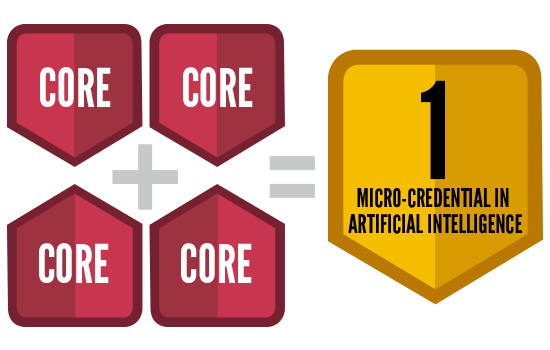
Micro-credential in Artificial Intelligence (MAI)
Program Overview
This page contains information and guidelines for students interested in pursuing the Micro-credential in Artificial Intelligence (MAI) from the Hewlett Packard Enterprise Data Science Institute (HPE DSI).
The purpose of the MAI is to recognize the expertise gained by students during their studies in the areas of:
Core Courses
- 212 Scientific Computing with Python
- 312 Introduction to Deep Learning
- 313 Introduction to Large Language Models
- 411 Selected Topics in AI
Cost
- Free for active University of Houston System (UHS) students, staff or faculty
- $250/course badge for non-UH individuals

How does it work?
4 Badges = 1 Micro-credential
Register and complete four HPE DSI courses. These should include 4 core courses listed and the HPE DSI will automatically award you the Micro-credential in Artificial Intelligence.
The Badge for the micro-credential will be awarded at the end of each semester.

Course Descriptions
Please note, that to receive the Micro-credential badge, make sure to complete the courses listed below.
These courses will neither affect your GPA nor appear in your transcripts.
The description for each course can be found below:
Scientific Programming with Python
Python is an easy to learn, powerful programming language. It has efficient high-level data structures that make it suitable for rapid application development.
Topics covered in this session will include data types, conditional and loop statements, functions, input/output, modules, classes and exceptions.
Upon completion of this tutorial series, participants should understand existing scientific Python codes and be able to write their own simple Python applications.
This training session also introduces participants to scientific computing extensions of Python like NumPy for use in high-performance computing. Advanced Python libraries like regular expressions, SciPy, pandas, seaborn, scikit-learn, etc. for every day scientific computing will also be covered in the course.
Deep learning refers to AI/ML techniques that utilize multilayer (deep) artificial neural networks. This branch of data science has seen exponential improvements in performance as our ability to collect, store, and process digital data has dramatically increased. Prediction, classification, regression, and identification of semi/unstructured data are areas where deep learning techniques exhibit a significant comparative advantage. Please note, this course requires familiarity with some basic concepts which are present in most programming languages: primitive and non-primitive data structures and operators, conditional and repeated execution, and working with libraries/modules. All programming work in this course will be done using Python, a beginner-friendly language.
Introduction to Large Language Models
In today's data-driven world, the ability to work with and understand human language is a critical skill. This course in Natural Language Processing (NLP) and Large Language Models offers a comprehensive exploration of the technologies that have revolutionized the way we interact with and analyze textual data.
In the technical aspects, students will also gain insights into the practical applications of NLP and large language models in various fields, including natural language information retrieval, sentiment analysis, named entity recognition, text classification, and data generation.
By the end of this course, students will have a good understanding of NLP and large language models, enabling them to apply these cutting-edge technologies to solve complex problems, drive innovation in their respective domains, and contribute to the responsible development of AI-powered applications. All programming work in this course will be done using Python, a beginner-friendly language.
This course introduces additional topics in AI, including ethics and aesthetics and discussions about how AI might change our relationship to knowledge. We will draw on current literature. In addition, selected speakers from industry will present the use of AI in industry. This course does not require any technical knowledge of AI.
Registration
UH Students
- Login to Moodle to sign up for each course (access this link via campus WIFI or the UH VPN).
Non-UH/Alumni
- Complete the payment of the course fees ($250.00 per course) at least three (3) weeks before course commencement. The URL and payment links are available on the course page.
- Inform the HPE Data Science Institute by email of your interest in taking the course at least three (3) weeks before the course start date. This will allow adequate time for processing of your course access credentials before the first-class meeting.
**You may email us at contact@hpedsi.uh.edu for additional information.
Retroactive Badges
Please email the HPE Data Science Institute if you have completed any of the four HPE DSI courses listed on this page on or after the Spring 2019 semester.
Micro-Credential Badges
All the students who have successfully completed the Micro-credential in Artificial Intelligence (MAI) are encouraged to fill out the badge petition form.
Micro-credential in Artificial Intelligence (MAI) Application Form
**Please note: The form can only be filled by students who have received the badges for all the courses (as listed on this web page).

Badgr Instructions
Link your HPE DSI Badges to a Badgr account and share them on online platform (e.g., LinkedIn).
Create a Badgr account at badgr.io if you don’t already have one.
- Enter the sign in credentials for your Badgr account in the Moodle Backpack page to request to connect.
- If successful, the backpack status will change to “Verification pending”.
- Check the email account you registered with Badgr for a verification email from HPE DSI.
- Click on the verification link in the email to confirm and activate the connection of your Moodle backpack to your Badgr backpack.
- If successful, the link will take you to your Moodle Backpack page and the status will change to "connected".
- Go to the “manage my badges” page, where you will see a list of all your earned HPE DSI Badges.
- Click on the specific HPE DSI Badge you want to share; the link will take you to a details page about the Badge.
- Click on the "Add to Backpack" button.
- If successful, you will be taken back to the “manage my badges” page, which will now display an “Added badge to backpack” notice. You will also receive an email from Badgr noting that you have earned this Badge.
- Sign in to your badgr.io account.
- Select the Badge you want to share from the list.
- Click on “Share” to generate a URL or link it to social platforms; Click on "Download" to save it on your computer device.